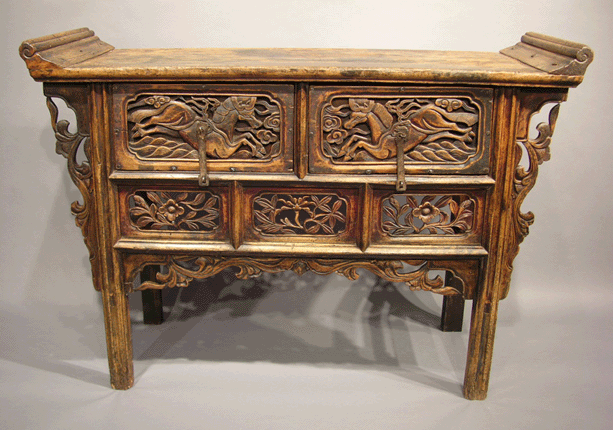 15th c; Sophora (Huai) framework, cypress and miscellaneous wood side panels; rare “Heavenly Stallions” carvings; Shanxi.
15th c; Sophora (Huai) framework, cypress and miscellaneous wood side panels; rare “Heavenly Stallions” carvings; Shanxi.
36” h x 51” w x 17” d

This table is special not only due to its age but also because it is made of Sophora, an extinct wood, and its unique cravings.
The Sophora wood is very dense due to the tree’s extreme slow growth; since it also naturally resists moisture and insect damage, it was the wood of choice as furniture building material during the Yuan and Ming dynasties. Its over-use caused the demise of this wood by the end of the Ming period.
The top of this table is made of a single plank of Sophora. It has molded everted ends showing hand-hammered boss-head nails, which are also found on the frame of the two drawers below. The two drawer front panels have deep relief carvings of the mythical Heavenly Stallions galloping across waves and through clouds, with the three panels below having openwork carvings of floral and leafage motifs. These motifs have a distinctive provincial flavor reflecting the culture of the northern nomadic minorities which populated China during the Yuan dynasty and influence artwork during the early Ming period. These nomads were used to things in nature like flowers and grass, birds and small animals, and often used them as motifs. They also have a special relationship with their horses as they roam the land for grass and water to nourish their herds, or at war. “Heavenly Stallions”, however, are rarely seen as a decorative motif on their furniture.
On this table, the scrolled everted ends of the top panel show boss-head nails construction. The drawer fronts retain original hasp plates that secure the drawers to rings on the frame member below them. The locks are missing. The front legs of this table are molded and are tenoned through to the top panel. The front spandrels have carvings of flourishing leafage motif. The back has no spandrels and is supported by plain legs of which one has a part replaced due to severe rotting from sitting on muddy floors of a warehouse during social upheaval of the 1950s. The sides have two stretchers spanning the legs.
This table was found in Shanxi in the 1990s, sporting a greyish worn patina of old age and neglect. The luster of the wood was restored after the piece was cleaned and polished with an application of the natural “lac” from the lacquer trees that flourished in Shanxi. The lac not only restored the luster of the wood but also helped to preserve the wood.